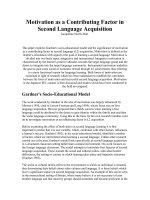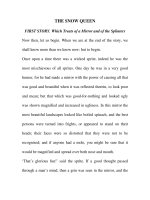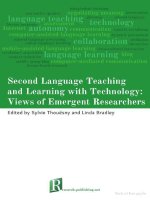First and second language acquisition 2
Bạn đang xem bản rút gọn của tài liệu. Xem và tải ngay bản đầy đủ của tài liệu tại đây (1.04 MB, 89 trang )
HS: Language and the Mind
Prof. R. Hickey
SS 2006
First and Second Language Acquisition
Tatiana Prozorova (HS/TN)
Irina Novikava (HS/TN)
Alexandra Wolek (HS/LN)
Vanessa Hollands (HS/LN)
Verena Scheulen (HS/LN)
Nadiya Sowa (HS/LN)
Kirsten Leicht (HS/TN)
Overview
•
•
•
•
•
•
Instruction and Second Language Acquisition
Variation in Child Language
Psychosocial Aspects of Language Acquisition
Social and Discourse Aspects of Interlanguage
Psycholinguistic Aspects of Interlanguage
Contrastive Linguistics
Instruction and Second Language
Acquisition
Tatiana Prozorova
Irina Novikava
Structure
main theories dealing with instruction in L2 acquisition
effectiveness of instruction
key principles for an effective instruction
instructions appropriate to each acquisition stage
ten things the teacher can do to improve instruction for
ELL students
Introduction
Grammar Translation Method
Audiolingual Method
non-communicative approach that relies on reading and
translation, mastery of grammatical rules and accurate writing
non-communicative approach that involves heavy use of mimicry,
imitations and drill. Speech, not writing is emphasised
Communicative Language Teaching
is based on the assumption that learners do not need to be taught
grammar before they can communicate but will acquire it
naturally as part of the process of learning to communicate
Basic theories of L2 acquisition
"Comprehensible Input" hypothesis (by Stephen Krashen)
"Comprehensible Output" hypothesis (by Merrill Swain and others)
learners acquire language by "intaking" and understanding language that
is a "little beyond" their current level of competence
providing learners with opportunities to use the language and skills they
have acquired, at a level in which they are competent, is almost as
important as giving students the appropriate level of input
Affective Filter hypothesis (by Krashen and Terrell)
individual’s emotions can directly assist in the learning of a new language
Basic theories of L2 acquisition
Basic interpersonal communications skills (BICS) and
cognitive academic language proficiency (CALP)
Context-embedded communication
Context-reduced communication
provides fewer communicative clues to support understanding
Cognitively undemanding communication
provides several communicative supports to the listener or
reader(objects, gestures, vocal inflections)
requires a minimal amount of abstract or critical thinking
Cognitively demanding communication
requires a learner to analyze and synthesize information quickly
and contains abstract or specialized concepts
Four key principles for an effective
instruction
Increase Comprehensibility
Increase Interaction
language skills are used in real-life situations
Increase Thinking/Study Skills
involves the ways in which teachers can make content more
understandable to their students
advanced thinking skills are developed
Use a student’s native language to increase
comprehensibility
Examples of Instructional Strategies
Silent/ Receptive Stage I
Use of visual aids and gestures
Slow speech emphasizing key words
Do not force oral production
Write key words on the board with students copying them as they are
presented
Use pictures and manipulatives to help illustrate concepts
Use multimedia language role models
Use interactive dialogue journals
Encourage choral readings
Use Total Physical Response (TPR) techniques
Examples of Instructional Strategies
Early Production Stage II
Engage students in charades and linguistic guessing games
Do role-playing activities
Present open-ended sentences
Promote open dialogues
Conduct student interviews with the guidelines written out
Use charts, tables, graphs, and other conceptual visuals
Use newspaper ads and other mainstream materials to encourage
language interaction
Encourage partner and trio readings
Examples of Instructional Strategies
Speech Emergence Stage III
Conduct group discussions
Use skits for dramatic interaction
Have student fill out forms and applications
Assign writing compositions
Have students write descriptions of visuals and props
Use music, TV, and radio with class activities
Show filmstrips and videos with cooperative groups scripting the
visuals
Encourage solo readings with interactive comprehension checks
Examples of Instructional Strategies
Intermediate /Advanced Proficiency Stages IV & V
Sponsor student panel discussions on the thematic topics
Have students identify a social issue and defend their position
Promote critical analysis and evaluation of pertinent issues
Assign writing tasks that involve writing, rewriting, editing, critiquing
written examples
Encourage critical interpretation of stories, legends, and poetry
Have students design questions, directions, and activities for others to
follow
Encourage appropriate story telling
Ten Things the Teacher Can Do To
Improve Instruction
1.
2.
Enunciate clearly, but do not raise your voice. Add gestures, point
directly to objects, or draw pictures when appropriate
Write clearly, legibly, and in print—many ELL students have
difficulty reading cursive
3.
4.
Develop and maintain routines. Use clear and consistent signals for
classroom instructions
Repeat information and review frequently. If a student does not
understand, try rephrasing or paraphrasing in shorter sentences and
simpler syntax. Check often for understanding, but do not ask "Do
you understand?" Instead, have students demonstrate their learning
in order to show comprehension
Ten Things the Teacher Can Do To
Improve Instruction
5.
6.
7.
8.
9.
10.
Try to avoid idioms and slang words
Present new information in the context of known information
Announce the lesson’s objectives and activities, and list instructions
step-by-step
Present information in a variety of ways
Provide frequent summations of the salient points of a lesson, and
always emphasize key vocabulary words
Recognize student success overtly and frequently. But, also be
aware that in some cultures overt, individual praise is considered
inappropriate and can therefore be embarrassing or confusing to the
student
Conclusion
The main theories dealing with instructions in L2 acquisition
have been considered
Instruction can be both successful and non-successful
Four key principles for an effective instruction have been
pointed out
Examples of concrete instructions appropriate to each
acquisition stage have been introduced
/>Rod Ellis Second Language Acquisition. Oxford University Press
Thank you for your attention!
NEXT PART
Language and the Brain
Prof. R. Hickey
SS 2006
Variation in child language
Aleksandra Wolek (Hauptstudium LN)
Content:
Characteristics considering first language acquisition
Basic requirements for first language acquisition
Variation in child language
Variation in rate
Variation in route
Types of variation
Direct & indirect influences
Summary
Conclusion
Characteristics considering first
language acquisition :
It is remarkable for its speed
In normal conditions language acquisition generally
occurs
Small differences in a range of social and cultural factors
have, according to various studies, no meaning
Belief that there is some “innate” predisposition of
human child to acquire language exists
TRUTH: each human child posses a language
-faculty
Basic requirements for first
language acquisition
Biological aspects must be fulfilled
This process requires interaction
Language must be culturally trasmitted
Variation in child language
Variation in rate
Variation in route
Types of variation:
Inherited attributes:
Sex, intelligence, personality and learning style
Social background:
Family structure,
cultural
environment, social
group affiliation
Child's linguistic
behaviour
Style of linguistic
interaction: interpersonal
relations etc.
Situation: setting,
activity, number of
participants
Direct & indirect influences
Indirect influence:
Social background
Direct influences:
Inherited attributes
Situation
Style of linguistic interaction
Inherited attributes:
Sex
no genetic superiority of girls
Intelligence
correlation between language and intelligence
strongly related to environmental variation
Personality and learning style
no strong evidence for such relationship, still
demands researching









